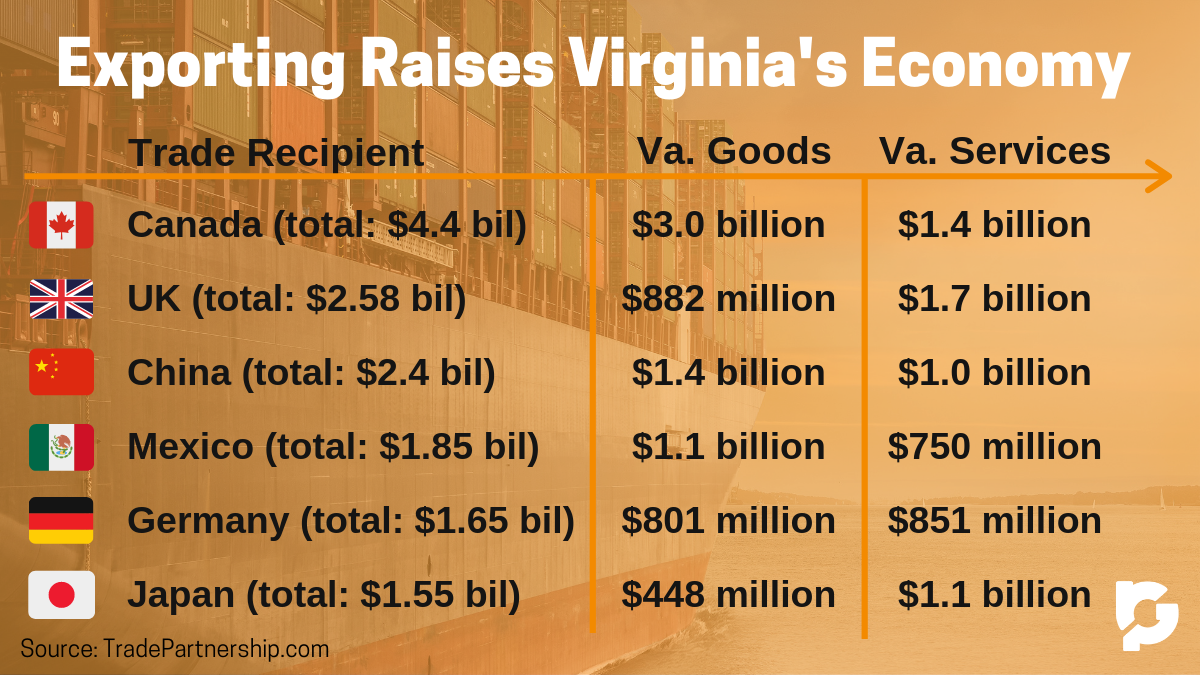
News
Blog | 8 min read
May 30, 2019

A recent report by Business Roundtable, a nation-wide consortium of CEOs which promotes an expanded U.S. economy, found that Virginia’s businesses could significantly benefit by exporting goods and services to foreign markets.
With more than 95% of the world’s population and 80% of the world’s purchasing power outside the United States, future economic growth and jobs for Virginia and America increasingly depend on expanding U.S. trade and investment opportunities in the global market place.
On a local scale, the Metro Richmond Exports Initiative, a program of the Greater Richmond Partnership, assists central Virginia businesses export their goods and services with special educational and networking programs, grants and scholarships, and other resources. The non-profit program also works to make local businesses and organizations more aware of the benefits of exporting.
For the last 25 years, total U.S. exports have increased at an average annual rate of 5.5 percent, notwithstanding recent declines and the declines experienced during the 2001-2002 and 2008-2009 recessions. The United States exported an estimated $1.5 trillion in goods and $752.4 billion in services in 2016. Between 2006 and 2016, U.S. goods exports have increased by 41% and services exports by 81%:
Virginia-made goods and services are purchased by customers in 214 countries and territories, including billions of dollars in annual exports to top markets like Canada, the United Kingdom and China. Virginia’s exports have grown at an average annual rate of 2.0% since 2007.
“We care about all the trade agreements that the United States has. We don’t believe we have enough of them. One in five jobs at DOW and DOW DuPont is supported by a trade agenda” — Andrew Liveris, Chairman & CEO, Dow
One of the key factors that determine company valuation is market risk. Since exporting companies operate in more than one economy, they spread out their market risk, and thereby reduce it. Also, most exporters enjoy higher margins, and that raises their earnings before interest, taxes, depreciation and amortization (EBITDA). Exporting plants also are less likely to go out of business due to market diversification.
Starting in 2017, large companies account for 70% of the value of Virginia’s goods exports, with the rest provided by small- and medium-sized enterprises (SMEs). However, of the 7,250 Virginia businesses that exported in 2016, 84% were small- and medium-sized businesses. The U.S. International Trade Commission found that U.S. small- and medium-sized enterprise (SMEs) manufacturing exporters earned more per firm than non-exporters.
In 2017, Virginia companies exported an estimated $15.9 billion in goods and $17.4 billion in services. Between 2007 and 2017, Virginia goods exports have decreased by 3%, but services exports increased by 48%.
In 2017, Virginia companies exported an estimated $15.9 billion in goods and $17.4 billion in services.
In addition to exporting directly themselves, thousands of American SMEs export indirectly when they sell goods and services to large U.S. exporters. Based on their direct and indirect export activity combined, SMEs represent more than 40 percent of the value of U.S. exports.
An added benefit includes the creation of intellectual property (IP) while developing export strategies. A study done by professors at the University of Southern California and the University of Minnesota found that two years after exporting, exporters file seven times more patents and deliver four times more product innovations than non-exporting peers. That’s because exporters can often access diverse knowledge bases not available in the domestic market.
Virginia ranks among the top 10 state exporters in 14 industries, including:
Virginia is America’s 26th largest exporter of agricultural products, which is the state’s largest sector of its economy. It is the sixth-largest exporter of aquaculture, the ninth largest exporter of miscellaneous crops, the 14th largest exporter of cattle, and the 18th largest exporter of fruits & tree nuts.
One of Virginia’s fastest-growing export categories is converted paper products, which increased by 86% since 2007. In 2017, exports of these products reached $253 million. Canadian-based Cascades recently purchased an existing paper plant with plans to spend up to $300 million to upfit the facility for paperboard processing.
When asked about exporting, most companies think of shipping a tangible object overseas. However, it’s much easier for service companies to export because of advances in communication and technology. Virginia’s top service exports for 2017 include travel at $3.3 billion, management and consulting services at $2.9 billion, and computer and data services at $2.1 billion.
Virginia’s exports have grown at an average annual rate of 2% since 2007 and goods and services exports accounted for 6.5% of the state’s gross domestic product (GDP) in 2017.

The biggest impacts of trade are the ways in which it increases spending across the U.S. economy. But most analysts seeking to assess the impacts of trade on U.S. jobs stop with the direct and indirect impacts of exports and imports. In doing so, they miss the largest source of job-creating activity that comes from trade: the extra spending power companies, workers and consumers have in their bank accounts, spending power that generates still more job-supporting economic activity.
International trade, including exports and imports, supports 1,054,000 Virginia jobs—more than one in five. These trade-related jobs grew four times faster than total employment from 1992 to 2017 and are at large and small companies, on farms, in factories, and at the headquarters of Virginia’s globally-engaged firms. Jobs in export-dependent industries pay about 16 percent more than jobs in less export-intensive industries due in part because of the added revenue.
Export growth increases jobs by generating new business for Virginia’s manufacturers, service providers and farmers. Imports support jobs and keep costs low, helping Virginia businesses compete and saving Virginia families real dollars at the cash register. Also, labor productivity, as measured by revenue per employee, was more than 70% greater for exporting SMEs.
According to the U.S. Census, exporting facilities with less than 250 employees had 1.9 times more revenue than non-exporting plants. These facilities also increase employment 2 to 4 percent faster annually than plants that do not export.
In an analysis of the national employment estimates by state, every U.S. state realizes a net positive impact from trade. Not surprisingly, the largest states benefit the most. Shares of total state employment related to trade ranged from a low of 17% (Wyoming and Oklahoma) to a high of 21% (Nebraska and South Dakota).
Trade supports jobs not just at companies that export and import. Trade supports higher wages for workers and lower costs for companies and consumers, providing them with more money to spend on other things. This spending supports additional jobs throughout the U.S. economy in sectors like entertainment, education and construction.
Free trade agreements (FTAs) have helped fuel rapid export growth from Virginia to partner countries. In 2017, $5.9 billion of Virginia’s goods exports—or 37%—went to FTA partners. This represents an increase of 13% since 2007.
Trade agreements level the playing field by lowering other nations’ trade barriers, opening up foreign markets to U.S. exports and setting strong, enforceable rules for trade between the United States and other countries.
In 2017, $5.9 billion of Virginia’s goods exports, or 37%, went to FTA partners. And from 2007 to 2017, Virginia’s goods exports to countries with FTAs increased by 13%. In 2017 alone, $4.3 billion of Virginia’s services exports—or 24%—went to FTA partners.
FTA partners purchased 8.6 times more goods per capita from Virginia than non-FTA partners in 2017, including:
If the above data isn’t motivating enough, then it may be for your competitors.
However, Richmond Region companies have a distinct advantage: The Metro Richmond Exports Initiative.
Since the 1600s, the James River has made the Richmond region an excellent location for trade and exporting. That legacy continues today with state and local resources ready to help your company get started exporting. By utilizing Greater Richmond’s central location, marine terminal facilities, and easy access to the Port of Virginia, interstates and international airports make it the ideal choice as a center of international trade.
